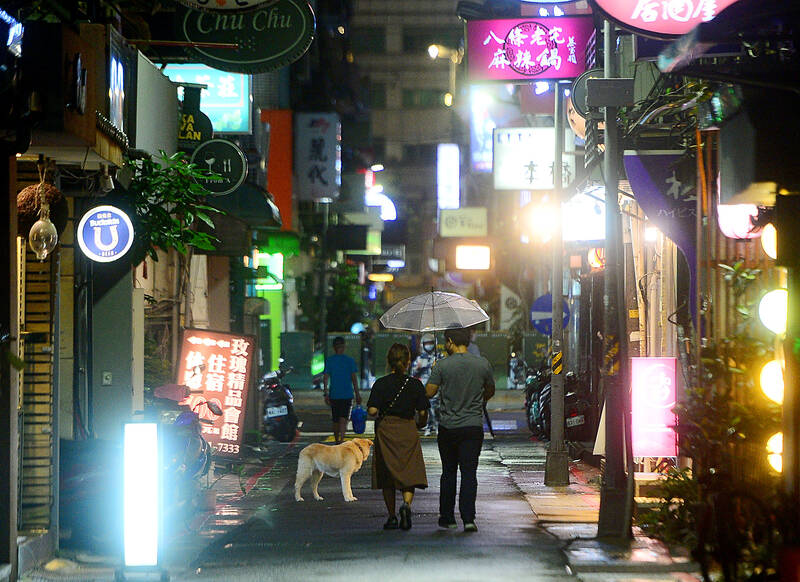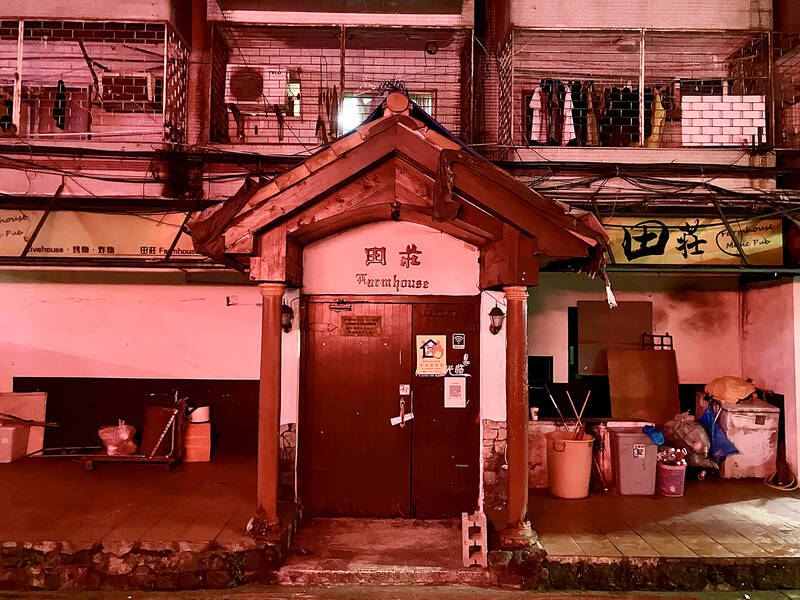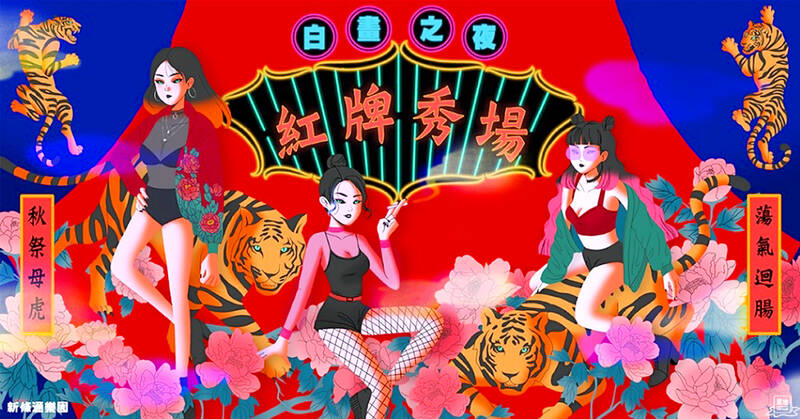In December of last year, Taipei City building inspectors condemned the Farmhouse Pub, a live music venue that in the 1980s served as the crucible where future Mandopop megastars were cutting their teeth. It was the bar where Wu Bai (伍佰) met his band China Blue, balladeer Zhao Chuan (趙傳) made an attempt at singing Judas Priest and Mandopop icon Harlem Yu (庾澄慶) belted out American top 40 hits of the day.
Despite its storied history, Farmhouse’s final shuttering was not commemorated with any social media posts or tributes. The venue, opened in 1985 by British expat Mike Cottingham, had changed owners multiple times and long outgrown the pub rock trend upon which it was founded. Though bands still took to its old stage up to its final days, they mostly played tired cover songs to an empty room.
Building inspectors closed Farmhouse, pasting a notice on the front door saying that after 37 years in operation the venue was in violation of fire safety codes. By late summer of this year, Farmhouse’s wooden sign was finally pried off the door. Now the venerable rock pub has been replaced by a faux-glitz nightclub where male patrons sit at discrete tables to drink overpriced whisky with in-house escorts.

Photo: Wang Yi-sung, Taipei Times
BIRTH OF TAIWAN’S BAR CULTURE
The music venue’s disappearance is just the latest loss for Taipei’s oldest bar district, which since the 1980s has been known as the “Combat Zone,” though its history in fact dates back to the 1950s and the arrival of the first American troops in Taiwan.
“American bar culture in Taiwan started here, in the Combat Zone,” says Jimmy Chen (陳俊明), owner of Patina, one of about a dozen remaining bars.

Photo: David Frazier
I’m chatting with him in the Green Door, the Combat Zone’s oldest existing bar, opened in 1977. He orders a fresh bottle of Jameson’s, which a Filipina barkeep sets on the bar in front of him. He begins to pour his own drinks.
“When I first opened in 1987, there were 40 or 50 bars on this street,” Chen continues. “It was almost impossible to find an empty shop front, because they were all taken.”
Then around 20 years ago, he says, the Taipei City Government wanted to make it a pedestrian street and into a Taipei version of Hong Kong’s famed bar district Lan Kwai Fong.

“But the problem was that probably half the bars were improperly licensed,” Chen says, “The owners were afraid of paying higher tax. So it never happened.”
In the 1980s as now, the Combat Zone centered on a dingy back lane less than 200m long, Shuangcheng St, Lane 132. The oldest remaining watering holes on this stretch — My Place, which opened in 1982, and the Manila, which also dates back to the 1980s — all have stained hardwood bars and incorporate touches of Americana and British-style pubs. The Green Door, where we are seated, is just around the corner on Dehui St, and boasts similar decor.
US MILITARY PRESENCE

Photo: File
This nightlife strip originally sprang up around the US military headquarters for all Taiwan, which was once just a five minute walk away. Established in 1951, the Military Assistance and Advisory Group (MAAG) was located at the intersection of Zhongshan N Rd and Minzu Rd, and at its height included administrative offices, military housing, a bowling alley, movie theater and the Naval Exchange, a department store selling American goods.
The only remnant of the old MAAG compound today is a group of low gray buildings just north of the intersection of Linsen N Rd and Minzu E Rd occupied by Taiwan’s Military Police Command. The rest was torn down shortly after the US ended its military presence in Taiwan in 1979 and is now occupied by the Maji Square bar and restaurant district, Flora Expo Park and the Taipei Fine Arts Museum (opened in 1983).
Though US bases in Taipei had their own military clubs featuring live bands and entertainment, they did not have women. The first zone of Western bars to emerge in Taipei — and for that matter all of Taiwan — was a kilometer and a half down Zhongshan N Rd from MAAG’s front gate on Jinzhou St (錦州街), which by the mid-1950s had come to be known as “Sin Alley.” This was the origin of Zhongshan North Rd’s reputation as a nightlife district, an aura still known to taxi drivers today.
There were only three bars then — Little Woman Bar, the Diamond Horseshoe Bar and the American Bar. As in post-World War II Japan, they employed bar girls or “hostesses” to sit with GIs as long as they were plied with overpriced drinks. Sometimes, the women could also be purchased out of the bars as prostitutes.
‘SUGAR DADDY ROW’/
Zhongshan North Rd did not finally explode as a sprawling bar zone however until the mid 1960s and the Vietnam War. In 1965, the US military instituted an R&R program, which allowed combat soldiers leave to cities around Asia, including Bangkok, Hong Kong, Tokyo, Manila, Singapore and Taipei. From 1965 to 1972, the R&R program brought more than 200,000 GIs to Taipei on five-day trips.
At the same time, the number of government-licensed prostitutes in Taiwan also skyrocketed, from around 2,000 in 1962 to over 20,000 in 1970. In 1972, one scholar estimated the actual number of Taipei sex workers, including many without licenses, at more than 100,000.
A GI landing in 1968 at the Taipei International Airport (Songshan Airport today) would have been greeted with a booklet 26 Bars in Taipei and directed to an R&R center known as the Sea Dragon Club on the west side of Zhongshan N Rd (now the campus of Tatung University).
He would have found bars sprawling all the way from Changchun Rd in the south up to the gates of the MAAG compound, with hot spots along Jinzhou St, Minquan W Rd, and Fushun St.
The easiest to access, however, was a strip immediately across the street from the R&R center nicknamed “Sugar Daddy Row,” which included the Paris Club, Madame Butterfly Club, Bunny Club, Mayflower Club, Lido Club and Black Cat Club.
There were actually far more than 26 bars during those R&R days, but military booklets only included those that were “in bounds,” meaning that they were approved by both MAAG and Taipei’s Foreign Affairs Police.
It was an open secret that Zhongshan North Rd had transformed into a sprawling red light district, though one neither Taiwanese nor US officials cared to advertise. Nevertheless, controls were put in place. Venereal disease checks and police-issued prostitution licenses were required for bar girls, while a GI was required to fill out a “Registration Form of Outgoing Waitress” before he could take a woman home.
ECONOMIC MIRACLE
Taipei’s era of US military bars ended with the 1970s and the break in diplomatic relations with the US in 1979. But riding the coattails of Taiwan’s economic miracle, the bar zone roared back in the 1980s, finding new patrons in Western businessmen sourcing “Made in Taiwan” products from local factories.
The new business clientele however were put off by the “girls drinks” and “artificial fun” of the Vietnam-style girlie bars. Instead, they gravitated towards the area’s first Western-owned places — the Horseshoe, Ploughman Pub and Green Door — which featured straight-forward pricing, Western comfort food, dart teams and live music.
One of the pioneers was Mike Cottingham, who opened The Ploughman Pub in 1978 and several other “Ploughman” bars through the 1980s. He claimed the Ploughman Pub was not only Taiwan’s first British pub, but it also set off a “pub” trend that swept Taiwan’s nightlife into the 1990s.
The 1980s was also when the Combat Zone got its name, though no one is quite sure where it came from. Over the years, I’ve asked dozens of bar owners and patrons, and no one can say for sure. Most think it is simply an homage to the military legacy, though it has also been suggested the name was borrowed from the US city of Boston, where a red light district was nicknamed “The Combat Zone” during the 1960s.
The Taipei Combat Zone’s gradual decline came with the end of the 1980s, both as Taiwan’s manufacturing moved to China and new entertainment districts emerged throughout Taipei. A few spots, like the B52s nightclub, transformed into Sunday hangouts for Filipino domestic workers, giving the area its second nickname, “Little Manila.”
“Now, the foreigners are all gone,” said My Place proprietor Jesse Chen (陳立榕), who purchased the bar eleven years ago.
COVID was especially difficult, Chen said, owing to a lack of business travelers. The nearby 300-room Imperial Hotel (台北華國大飯店) closed down for good, and Dutch airline KLM shifted its East Asia hub from Taipei to Seoul — the KLM flight crews were once his regulars.
Then earlier this year, Chen lost more patrons with the March shutdown of the Kuosheng nuclear power plant on Taiwan’s north coast, which meant the departure of expat engineers from Siemens and GE. Today, most of his clientele are local Taiwanese.
As the number of bars on Alley 132 has dwindled, two large chunks of the street have been torn down and replaced with luxury apartment buildings, while a few new hipster style businesses have also begun to appear throughout the neighborhood.
Today, only a few of the older bars — notably Malibu West, My Place and Patina — retain a steady stream of customers, and only in the Manila can you still pay to have a young waitress drink with you.
For now, says Patina’s Jimmy Chen, his bar is still profitable, though revenues are only half what they were a decade or two ago.
Taking a sip of whiskey, he looks at me and says, “The younger generation, why would they want to come to an oldies American bar?”
Then he shrugs and goes back to his bottle, adding, “I guess we’ll just have to see what comes along.”

April 14 to April 20 In March 1947, Sising Katadrepan urged the government to drop the “high mountain people” (高山族) designation for Indigenous Taiwanese and refer to them as “Taiwan people” (台灣族). He considered the term derogatory, arguing that it made them sound like animals. The Taiwan Provincial Government agreed to stop using the term, stating that Indigenous Taiwanese suffered all sorts of discrimination and oppression under the Japanese and were forced to live in the mountains as outsiders to society. Now, under the new regime, they would be seen as equals, thus they should be henceforth

Last week, the the National Immigration Agency (NIA) told the legislature that more than 10,000 naturalized Taiwanese citizens from the People’s Republic of China (PRC) risked having their citizenship revoked if they failed to provide proof that they had renounced their Chinese household registration within the next three months. Renunciation is required under the Act Governing Relations Between the People of the Taiwan Area and the Mainland Area (臺灣地區與大陸地區人民關係條例), as amended in 2004, though it was only a legal requirement after 2000. Prior to that, it had been only an administrative requirement since the Nationality Act (國籍法) was established in

With over 80 works on display, this is Louise Bourgeois’ first solo show in Taiwan. Visitors are invited to traverse her world of love and hate, vengeance and acceptance, trauma and reconciliation. Dominating the entrance, the nine-foot-tall Crouching Spider (2003) greets visitors. The creature looms behind the glass facade, symbolic protector and gatekeeper to the intimate journey ahead. Bourgeois, best known for her giant spider sculptures, is one of the most influential artist of the twentieth century. Blending vulnerability and defiance through themes of sexuality, trauma and identity, her work reshaped the landscape of contemporary art with fearless honesty. “People are influenced by

The remains of this Japanese-era trail designed to protect the camphor industry make for a scenic day-hike, a fascinating overnight hike or a challenging multi-day adventure Maolin District (茂林) in Kaohsiung is well known for beautiful roadside scenery, waterfalls, the annual butterfly migration and indigenous culture. A lesser known but worthwhile destination here lies along the very top of the valley: the Liugui Security Path (六龜警備道). This relic of the Japanese era once isolated the Maolin valley from the outside world but now serves to draw tourists in. The path originally ran for about 50km, but not all of this trail is still easily walkable. The nicest section for a simple day hike is the heavily trafficked southern section above Maolin and Wanshan (萬山) villages. Remains of